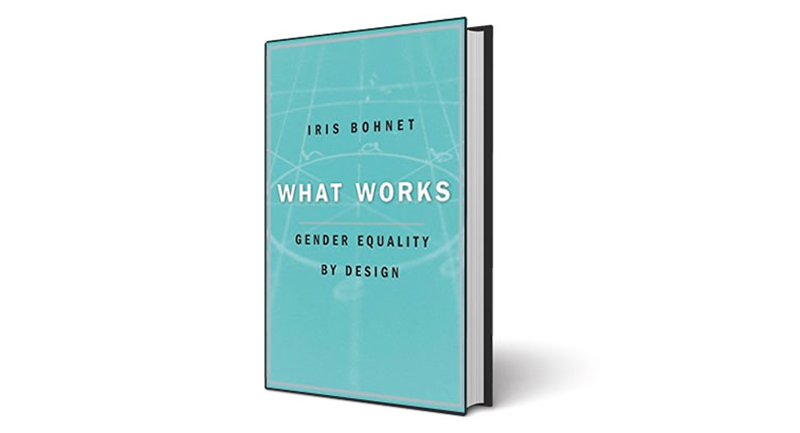
What Works: Gender Equality by Design discusses how organizations can leverage findings from behavioral science research to fight gender bias in the workplace—starting with job listings. Read an excerpt from the book below.
Attracting the right people instead of managing the wrong ones is one of the most important tasks any organization confronts. This is the mantra Google lives by—or, as Laszlo Bock writes: “Only hire people who are better than you.” In an interview on the company’s hiring and corporate culture, Eric Schmidt, the executive chairman, explained that in addition to judging the technical qualifications of potential hires, a key focus at Google was to determine whether they were passionate and committed to innovation.
Surely, allowing all Google engineers to spend 20 percent of their time developing their own ideas serves as a sorting device. It attracts creative, independent minds who invent Google News, Orkut, or a social networking site. The time is not written in stone nor necessarily utilized, but it matters as an idea: “No one gets a ‘20 percent time’ packet at orientation, or is pushed into distracting themselves with a side project. Twenty percent time has always operated on a somewhat ad hoc basis, providing an outlet for the company’s brightest, most restless, and most persistent employees—for people determined to see an idea through to completion, come hell or high water.”
Not many of those “seeing an idea through to completion, come hell or high water” are women. In the spring of 2015, a gender discrimination trial brought by a former junior partner at a venture capital firm in Silicon Valley drew renewed attention to the low fraction of women in technology. While in the end a jury found against the plaintiff, the low numbers were undeniable: fewer than 20 percent in most tech companies and even fewer in Silicon Valley’s venture capital firms.
Some argue that the “tech bros” mentality of Silicon Valley keeps women out and even discourages female students from focusing on computer science. Perhaps. Surely, the male-dominated environment does not help tech firms attract women. As we know, deviating from behavior that is expected of a social category, either by others or by oneself, can be costly. A woman who acts against the norms by definition doesn’t “belong”; not surprisingly, the fear of not belonging is influential.
Indeed, research by Boris Groysberg, Ashish Nanda, and Nitin Nohria (now dean of Harvard Business School) suggests establishing belonging turns out to be a major concern of female job seekers. They report that women consider more factors than men when screening jobs; in particular, cultural fit, values, and managerial style. There is a surprising silver lining to this research, however: it carries hidden benefits for women and their employers. In follow-up work, Groysberg identifies this scrutiny as one of the key variables explaining why women transition more successfully to new companies than men. Women know better what they are getting themselves into.
The researchers analyzed the performance of more than a thousand “star” analysts working for almost eighty different in- vestment banks over a nine-year period. Analysts were labeled “stars” if they were ranked as one of the best in the industry by Institutional Investor magazine. The team was interested in better understanding whether the analysts’ skills were portable when they switched companies. It turns out most analysts lost their stardom when they changed employers unless they moved to a better firm or brought their whole team along—with the exception of female analysts. Not only had the women studied a potential new employer more carefully before joining, they had also built their expertise differently than their male colleagues.
The top-performing female analysts had “built their franchises on portable, external relationships with clients and the companies they covered, rather than on relationships within their firms.” Or as one female star analyst put it: “For a woman in any business, it’s easier to focus outward, where you can define and deliver the services required to succeed, than to navigate the internal affiliations and power structure within a male-dominant firm.”
People choose organizations based on their preferences and their beliefs about whether or not they could thrive in a given organization. Messages shape those beliefs. Consider the messages sent when Lieutenant General David Morrison stated in a video posted on the Australian army’s official YouTube channel that he was committed to inclusion. “If that does not suit you, then get out,” Morrison flatly declared. “There is no place for you amongst this band of brothers and sisters.”
Acting in response to a 2013 investigation into sexual abuse, Morrison sent a strong message. In 2014, Morrison joined the Australian delegation to the Global Summit to End Sexual Violence in Conflict in London. Speaking again with admirable bluntness, he said that armies that assign more value to men than to women and tolerate sexual violence “do nothing to distinguish the soldier from the brute.”
Will these messages attract and retain soldiers valuing equality and inclusion? Time will tell. And while actions have followed his words, we all know that talk can be cheap. When and how messages affect behavior is a large field of inquiry in itself, but experimental evidence is rare. One example, however, is encouraging.
Robert Jensen and Emily Oster took advantage of the fact that cable television became available at different times in different parts of India, allowing them to trace whether attitudes and behaviors went along with exposure to the new information cable programming provided.
They found that the introduction of cable television was associated with improvements in women’s status in rural areas, including female school enrollment, decreases in fertility, as well as reported increases in autonomy and decreases in the acceptability of beating women and son preference. The information conveyed via cable television, often through somewhat surprising means, such as soap operas, exposed rural viewers to gender attitudes and ways of life, including within the household, more prevalent in urban areas. And it changed behavior.
Sorting mechanisms are powerful and often overlooked. Those charged with attracting the largest, most talented pool of applicants should make sure they scrutinize the messages, overt and biased, conveyed in their advertisements, websites, or other communications.









